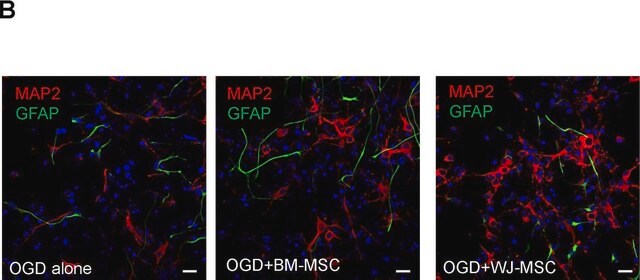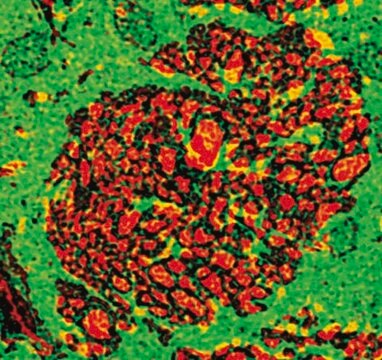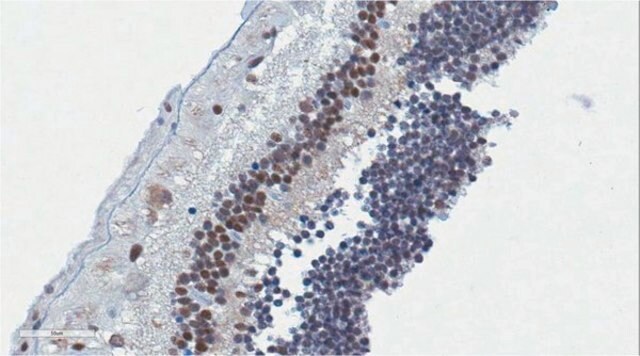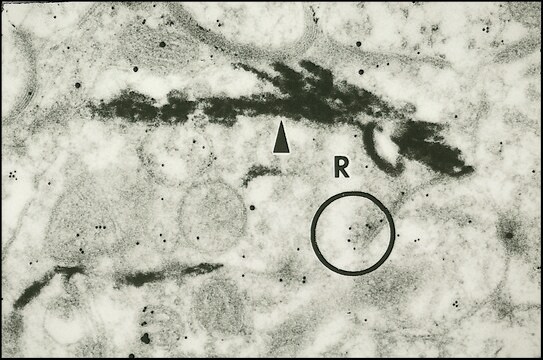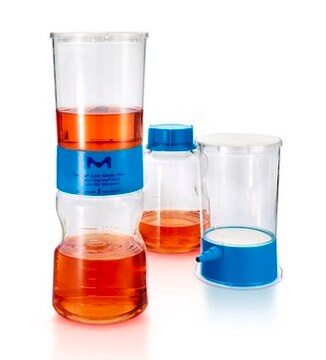AB1783
Anti-Glutamate Transporter Antibody, Glial
serum, Chemicon®
Synonym(s):
GLT-1, EAAT2
About This Item
Recommended Products
biological source
guinea pig
Quality Level
antibody form
serum
antibody product type
primary antibodies
clone
polyclonal
species reactivity
human, mouse, rat
manufacturer/tradename
Chemicon®
technique(s)
immunofluorescence: suitable
immunohistochemistry: suitable (paraffin)
western blot: suitable
NCBI accession no.
UniProt accession no.
shipped in
dry ice
target post-translational modification
unmodified
Gene Information
human ... SLC1A2(6506)
General description
EAAT2 transports L-glutamate and also L- and D-aspartate. It is essential for terminating the postsynaptic action of glutamate by rapidly removing released glutamate from the synaptic cleft. Acts as a symport by cotransporting sodium.
Specificity
Immunogen
Application
Western Blot: 1:500 dilution of this antibody detected GLT-1 on 10 ug of mouse brain membrane lysates.
Immunohistochemistry:
1:1,000-1:4,000 dilution from a previuos lot used a DAB detection system on adult rat forebrain fixed with 4% paraformaldehyde.
Immunohistochemistry:
1:5,000-10,000 dilution from a previuos lot used a cyanine conjugated secondary antibody.
Enzymatic detection requires substantially higher primary antibody dilutions. Lightly fixed 4% PFA material is recommended.
Notes:
Male Sprague-Dawley rats (b.wt. 100-150g) were anesthetized with sodium pentobarbital and perfused via the ascending aorta with 50 mL of Ca2+-free Tyrode+s solution followed by a formalin-picric acid fixative (4% paraformaldehyde with 0.4% picric acid in 0.16 M phosphate buffer, pH 6.9) for 6 minutes. Tissues were rapidly dissected out, postfixed in the same fixative for 90 minutes and rinsed for at least 24 hours in 0.1 M phosphate buffer (pH 7.4) containing 10% sucrose. Sections were cut (14 um) in a cryostat and incubated at 4°C overnight with AB1783 (1:5,000-1:10,000). After rinsing in PBS sections were incubated for 60 minutes at room temperature with Cy3-conjugated secondary antibodies. After mounting in a mixture of PBS and glycerol (1:3) containing 0.1% p-phenylenediamine, sections were examined with a Nikon Microphot-SA epifluorescence microscope.
Optimal working dilutions must be determined by the end user.
Neuroscience
Ion Channels & Transporters
Quality
Target description
Physical form
Storage and Stability
Analysis Note
Rat brain tissue
Other Notes
Legal Information
Disclaimer
Not finding the right product?
Try our Product Selector Tool.
recommended
Storage Class Code
10 - Combustible liquids
WGK
WGK 1
Certificates of Analysis (COA)
Search for Certificates of Analysis (COA) by entering the products Lot/Batch Number. Lot and Batch Numbers can be found on a product’s label following the words ‘Lot’ or ‘Batch’.
Already Own This Product?
Find documentation for the products that you have recently purchased in the Document Library.
Our team of scientists has experience in all areas of research including Life Science, Material Science, Chemical Synthesis, Chromatography, Analytical and many others.
Contact Technical Service

